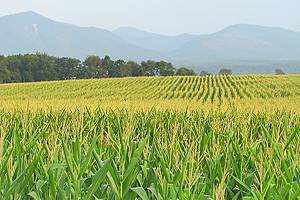HOLLINGSHEAD: Bio-economy still important to Iowa

HOLLINGSHEAD: Bio-economy still important to Iowa
September 7, 2008
As the demand for energy has risen, so has the price for agricultural products and everything from food to other living goods in the home.
Recently, ethanol has helped limit the burden at the pump for motorists. According to a new analysis by Merrill Lynch Commodity Strategist Francisco Blanch, “retail gasoline prices would be $21 a barrel higher, on average, without the incremental bio-fuel supply.” This translates to a $526 per year savings on gasoline for the average family. Blanch also calculates that U.S. ethanol production has increased corn prices by just 21 percent since 2004. Because a very small portion of the price of corn is passed through to retail food items, this means ethanol has increased household spending on retail food items by just $15 per year.
This is great for U.S. motorists, has benefited Iowa’s crop farmers, and, depending on how attached people are to livestock agriculture, it has been beneficial to the availability of ethanol byproducts. I question, however, consumers’ awareness of their savings, because prices overall have increased sharply for both fuel and food.
The real question is whether equipment manufacturers and seed, fertilizer and chemical suppliers bring the prices of their products down to a level farmers can afford when the top blows off. Also, will landlords bring the price of cash rent back down to a realistic level that a farmer can afford to pay? If an unprofitable trend continues for as many as 2-4 years, we could see a number of farmers sell off cheap land, as occurred during the 1980s.
From 2003-‘07, the average cost of planting an acre of corn was $286, and planting an acre of soybeans cost an average of $180. In 2009 it will cost an average of $529 to plant an acre of corn and $321 to plant an acre of soybeans, excluding land costs, according to the University of Illinois extension service. Depending on where you are in Iowa, land rents are bringing anywhere from $250 to $400 per acre.
Throughout history we have seen dark times in agriculture, but we have also seen golden times. There have been three eras of agriculture that have been golden since the 20th century. The first was in the early 1900s, which was known as “The Golden Era of Agriculture.” Then there was the golden period of the 1970s, and the third is the period that we are currently in. The first two both ended in economic crisis. Agriculture was steady after World War I, but then depression hit the whole country. After the 1970s’ boom time of agriculture we had the crash of the 1980s, when land values hit all-time lows. Land bought then is now finally back to its value before the 1980s’ slump.
Currently we are in uncharted waters about the future of energy and the future of agriculture. For those involved in agricultural production and having to make business decisions, and for those who gamble every day they walk out the door because it’s what they have done their entire lives, I wish them the best luck. If history repeats itself — which it usually does — we could see darker days ahead. Equipment manufacturers and seed, chemical and fertilizer suppliers will have to bring their prices back to a level that reflects the grain markets.
Having said all this, we still can be positive about the future, because the bio-economy is important to Iowa. It is important to a cleaner environment, and no one sees energy getting any cheaper. We do not want to forget the risk at hand. We often feel that everything is going so well, and all of sudden we are in an economic crisis. My warning to everyone is to manage your risk, and take precautions with the volatile markets of our time.
— Chet Hollingshead is a sophomore in agricultural education from Ogden.






